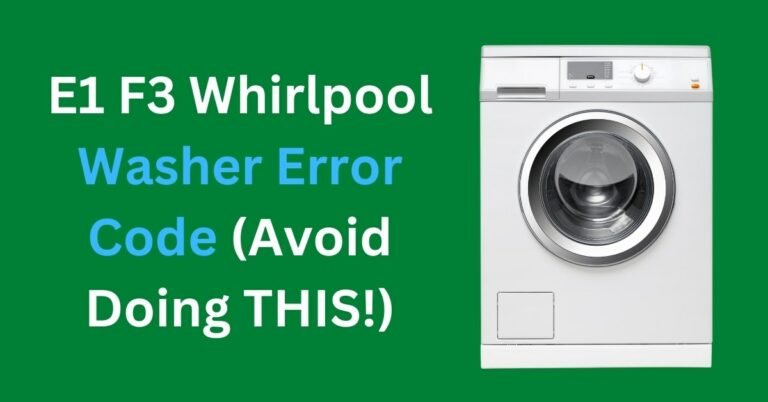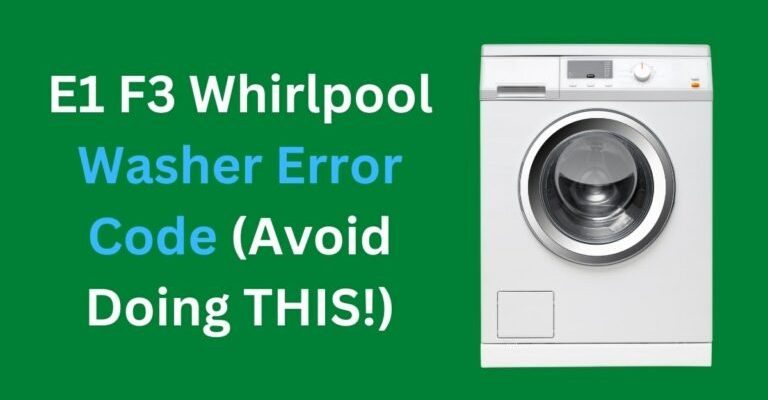
So what exactly does this mysterious “E1” mean? In simple terms, it indicates that your washing machine is having trouble filling with water. Think of it as a water-related roadblock. The washing machine is like a thirsty traveler running low on water, and without enough of it, it just can’t operate correctly. We rely on these machines to tackle one of life’s most mundane chores, and when they don’t work, it can throw our day into disarray. Now, let’s break down what causes this error code and what you can do about it.
What Causes the E1 Error Code in Whirlpool Washing Machines?
First off, let’s dive into the nitty-gritty of why this error code pops up. The E1 code mainly appears due to issues related to water supply. Imagine turning on a hose and nothing coming out—that’s essentially what’s happening inside your washing machine. The most common causes include blocked or kinked hoses, a problematic water inlet valve, or even low water pressure from your home’s plumbing system.
A blocked or kinked hose is like a pinched straw — it stops the flow of water. This is often the simplest cause to fix, as you might just need to adjust the hose to clear the kink. However, if the hose is blocked, you’ll need to clean it out. A more complex issue, such as a faulty water inlet valve, is akin to having a clogged faucet that needs attention. This part is responsible for letting water into the machine, and if it’s malfunctioning, your washing machine is left high and dry.
Another potential cause could be the water pressure itself. If your household water pressure is low, your washing machine might not be able to draw enough water. It’s like trying to fill a bucket with a trickle instead of a gush. Therefore, it’s crucial to check your home’s water pressure if you’re consistently facing this error.
Immediate Next Steps: What Should You Do?
Okay, so you’ve got the E1 error code. What next? First things first, let’s tackle the simplest fixes. Inspect the hoses at the back of your washing machine. Are they kinked or twisted? Straightening them out could be a quick fix. If they seem clogged, unplug the machine, detach the hoses, and give them a good rinse to clear any debris.
If the hoses are in good shape, move on to the water inlet valve. This part might need to be cleaned or replaced. Don’t worry if you’re not the handiest person around; think of this as a simple DIY project, like changing a light bulb. There are plenty of guides and videos online that can walk you through this process. However, if this feels too daunting, you might want to call in a professional who can diagnose the problem more accurately.
Sometimes, the source of the problem could lie beyond your washing machine. Check other faucets and showers in your home to see if the water pressure is unusually low. If so, the problem might stem from your main water supply, and you should reach out to your water utility provider to investigate the issue further.
Why You Shouldn’t Ignore the E1 Error Code
You might be wondering, “Isn’t my laundry machine still working despite this error?” While it might carry on for a load or two, ignoring the E1 error is like pretending a leaky roof doesn’t exist. Sooner or later, that drip could become a deluge. Operating your washing machine when it’s not filling properly can strain and damage the internal components, leading to costly repairs or even a full replacement.
Moreover, leaving this error unchecked could disrupt the entire laundry process. Your clothes might not get washed properly due to insufficient water, leaving them soapy and unclean. This can become frustrating when you’re left with less-than-fresh laundry that needs another go in a working machine.
Ignoring the problem might also mean risking potential water damage. If the problem is related to plumbing, a failure on that front could cause a leak or even a flood in your laundry area. By addressing the E1 error promptly, you prevent such risks and safeguard not only your machine but also your home.
Preventative Measures to Avoid Future Errors
To keep your Whirlpool washing machine running smoothly in the future, regular maintenance is key. Consider this akin to taking your car for regular servicing. First, periodically check and clean the water inlet filters—these can collect sediment over time, just as a coffee filter gathers grounds. Doing this ensures a steady flow of water to keep your machine happy.
It’s also wise to inspect hoses for wear and tear every few months. Think of it like checking your shoelaces before a run; make sure they’re secure and free of tangles. Replacing hoses every few years can prevent unexpected leaks or blockages.
Finally, be mindful of the water pressure in your home. If you consistently experience low pressure, it might be worth having a plumber assess your plumbing system. A well-maintained water supply system is the unsung hero of all your household appliances, ensuring they work efficiently without hiccups.
By staying proactive and promptly addressing any issues, you’ll keep your Whirlpool washing machine in tip-top shape and avoid the nagging headache that comes with error codes like E1. Remember, a stitch in time saves nine—or in this case, a simple check now can save you from a flood of problems later.
